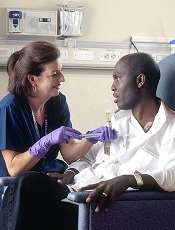
Credit: Rhoda Baer
A new study suggests that half of all people recently diagnosed with cancer in England and Wales should survive their disease for at least 10 years, whereas, 40 years ago, only about a quarter of cancer patients could expect the same.
The research, published in The Lancet, showed significant improvements in long-term cancer survival rates from 1971 to 2011, particularly among patients with hematologic malignancies.
Unfortunately, the outlook for some malignancies remained extremely poor over the period studied.
“Although survival for some cancers has improved dramatically over the past 40 years, others are lagging far behind,” said Manuela Quaresma, of the London School of Hygiene & Tropical Medicine in the UK.
“More investment is urgently needed to improve early diagnosis and provide the best treatment, including more specialist surgeons for poor-prognosis cancers like lung cancer, which have shown little or no evidence of improvement in long-term survival (5 and 10 years after diagnosis) over the past 40 years.”
Quaresma and her colleagues analyzed survival trends for more than 7 million adults (aged 15 to 99 years) diagnosed with one of 21 common cancers in England and Wales between 1971 and 2011, and followed up to the end of 2012.
The researchers observed an increase in 10-year survival for all cancers combined. Twenty-four percent of patients diagnosed in 1971-1972 survived at least 10 years. And 49.8% of patients diagnosed in 2010-2011 are expected to survive at least 10 years.
The data revealed substantial improvements for patients with hematologic malignancies as well. For Hodgkin lymphoma, the 10-year survival rate rose from 47.7% for patients diagnosed in 1971-1972 to 80% for those diagnosed in 2010-2011.
For non-Hodgkin lymphoma, the 10-year survival rate increased from 22% to 63.1%. For multiple myeloma, it rose from 6.2% to 32.6%. And for leukemia, it rose from 6.9% to 46.1%.
The researchers noted that the most recent 10-year survival estimates are above 70% for cancers of the breast, prostate, testis, and uterus, as well as for melanoma and Hodgkin lymphoma. Furthermore, improvements in survival are greatest for these cancers.
Unfortunately, several other malignancies continue to have poor long-term survival. For cancers of the brain, stomach, lung, esophagus, and pancreas, 10-year survival after diagnosis is still below 15% for patients diagnosed in 2010-2011.
“These 5 cancers impose a huge public health burden, both because they are common and because they are often diagnosed at a late stage, when they are much harder to treat,” said study author Bernard Rachet, MD, PhD, of the London School of Hygiene & Tropical Medicine.
Dr Rachet also noted that this research confirms a persistent “age gap” in survival between younger and older patients for all cancers.
“Even after we have adjusted for the fact that older people have much higher death rates from other diseases than younger people, elderly cancer patients are doing worse for all cancers,” he said.
“This problem is particularly marked in the UK. In other countries, the age gap in cancer survival has become much narrower over the last 15 to 20 years than in England and Wales.”

